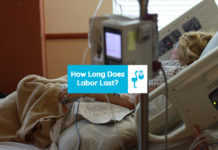Every woman undergoes false labor.
When you are near your due date, every movement makes you feel anxious about the start of labor.
You already go through a lot of mock drills due to the Braxton Hicks. The random contractions and tightening in the lower abdomen gives you feeling of labor.
During the late second trimester, you don’t feel the need to call your OB because your date is far.
But after you cross the 37-week false labor can bluff you to rush to the birth center.
Differences between false labor and real labor exist but getting confused is normal.
That is why doctors advise you to wait until active labor starts.
When your contractions are 4 minutes apart, 1 minute long happening over 2 hours, consider it real labor.
What is false labor?
When the contractions do not cause dilation and occur randomly, it is false labor.
There is no membrane rupture or removal of mucus plug. Labor does not proceed, and there is no strengthening of contractions.
Also when you change your position, the labor stops.
False labor can be because of round ligament pain that causes stretching. Braxton Hicks start in the second trimester and are false labor drills.

What does false labor feel like?
During false labor, you feel like your abdomen is getting tighter.
Unlike real labor, there is no pain in the back or other regions.
Your mucus plug does not move, and membranes are intact.
The contractions don’t get stronger and rapid. You can feel some discomfort if the cause of false labor is round ligament pain.
The duration of false labor is short. It is not necessary that false labor means that your real labor will start soon.
What do real contractions feel like?
You feel pain in your lower back spreading to the front.
True labor feels like rhythmic contractions of the uterine muscles.
You can consider it as multiple folds of menstrual cramps. It is not necessary that with the tick of the clock you start feeling the pain.
Some women take around 36 hours to go into active labor.
At the same time conditions such as rapid labor can push out the baby within hours.
How long can you have false labor contractions?
False labor contractions are not rhythmic.
You can have them for short time span on one day and longer on the other. There is no uniformity in the kind and duration of false labor.
If you are going to go in real labor, then you can experience false labor for longer. As time passes, the contractions get stronger and frequency increases.
Does false labor mean real labor is close?
As above it is not necessary that fake labor indicates impending real labor.
Sometimes it could be because of gas due to limited intestinal movements. When you are near your due date, then the contractions will lead to dilation.
You will feel the falling of mucus plug. Gushing fluids through the vagina indicate that your mucus plug is out.
When you have a combination of these symptoms, then false labor indicates real labor.
But if you change position and the contractions stop then labor is not near.
How long does false labor last before real labor starts?
It depends on which false labor are you experiencing at the moment. There is no direct relation between the two. Real labor happens at its own time.
The only cue you can take from the false labor is if contractions are getting stronger.
How are Braxton Hicks contractions different?
Braxton Hicks contractions are shorter and more like muscle spasms.
You will feel a contraction and then nothing.
Some pain can also accompany Braxton Hicks. But no bleeding or mucus plug is coming out.
There are irregular contractions and do not progress into active labor.
Contractions that don’t hurt are also Braxton hicks.
During real labor, there will be a lot of pain. Painless contractions can be bowel movements pushing the uterus.
When to go to the hospital for contractions?
You must call your doctor and inform about the contractions if they get stronger and frequent.
No matter what stage of pregnancy you are currently at there can be preterm labor.
10 signs of labor when you should call the doctor
- If there is any bleeding or spotting that is bright red
- Cervix dilation is more than few centimeters
- Membrane rupture occurs
- Baby is not moving at all or less than ten times in 2 hours
- Pain is spreading in your lower back and abdominal area
- Your water breaks and you feel gushing out of fluids
- Contractions are getting stronger and longer up to 60 seconds
- Change in position is not helping to calm the contractions
- You feel breathless or chest pain
- You’re near your due date, and contractions are getting faster
7 signs of false Labor: Braxton Hicks vs. real contractions
How to tell the difference between fake contractions and real labor?
When contractions stop, it means that it was false labor. Braxton hicks are small contractions. Irregular contractions will increase in time and tune when real labor has to start.
Here are differences between false labor and real labor to help you judge your condition.
1) Duration of contractions
The period of fake labor is way less than active labor. The contraction during false labor doesn’t last more than 30 seconds.
2) Frequency of contractions
The contractions must be strong and rhythmic lasting for a minute and happen over for more than 2 hours.
It is the 4-1-2 rule that mentions that contractions must be 4 minutes apart, 1 minute long and continue for 2 hours.
When the frequency of contractions is low, then it is fake labor. During true labor, the contractions get closer and closer.
3) Rhythm of contractions
There is no rhythm in false labor. Random tightening of muscles that eases with the change in position doesn’t count as labor.
While during real labor the contractions are like pulses sent across a rope. They are like waves of energy moving across the wall of the uterus.
4) Contractions stopped
Fake labor stops with the change in position and activity. It is possible that a specific exercise or posture causes such contractions.
Of course, real labor won’t stop and continue until delivery. No change of posture will stop the contractions.
5) Associated pain and symptoms
During active labor, there is a pain in the lower back and surrounding area. There may or may not be any pain during fake labor.
6) Mucus plug and membranes
False labor does not rupture any membrane and cannot remove the mucus plug. Real labor has three stages.
The second stage of active labor involves effaced uterus and removal of mucus plug.
7) Bleeding
During false labor, there is no bleeding. Any vaginal bleeding can be a sign of real labor starting soon.






![Why Do You Fast Before Cesarean? [Fasting Before C-Section Facts] Why do you fast before Caesarean?](https://www.pregnanteve.com/wp-content/uploads/2019/03/fast_before_cesarean-218x150.jpg)


